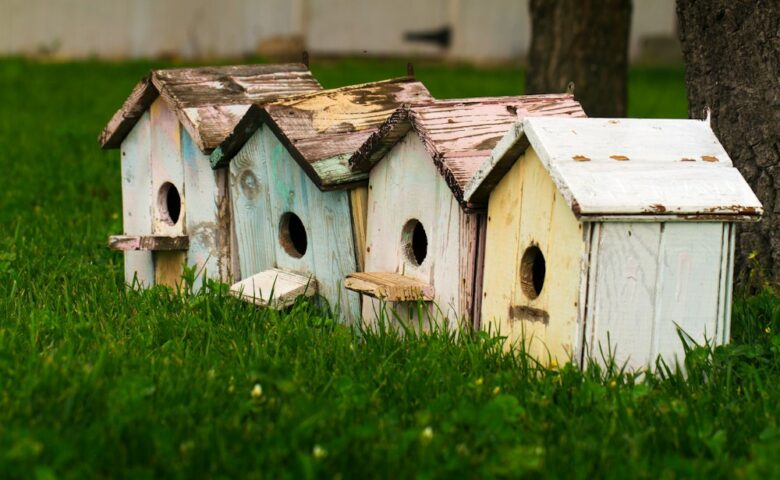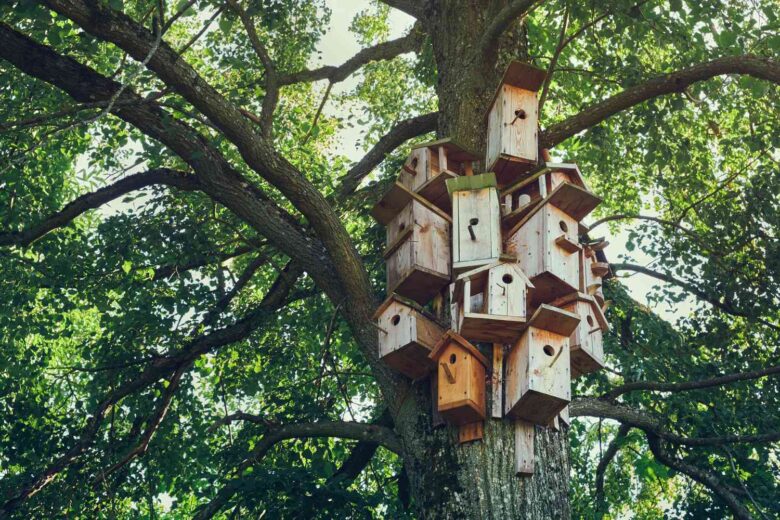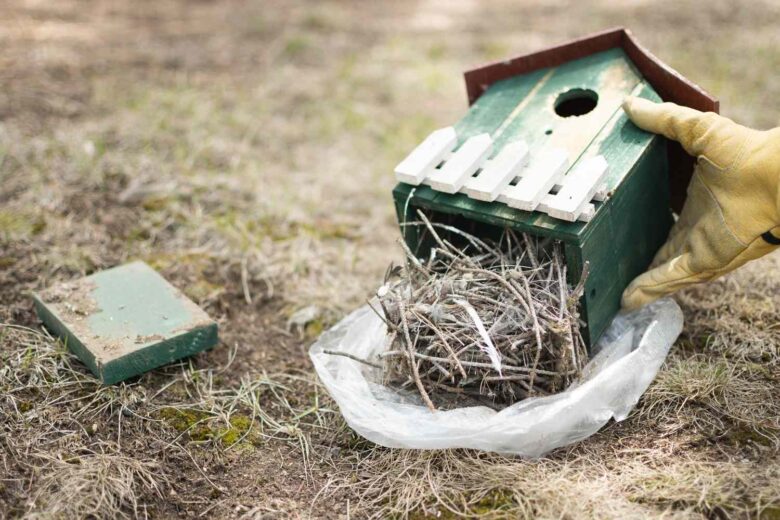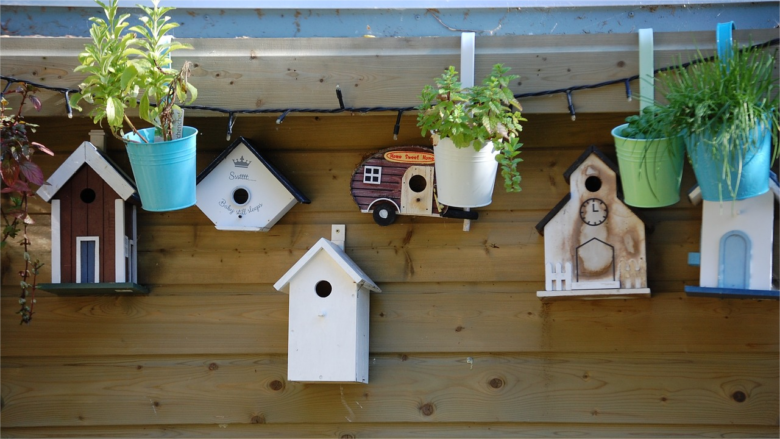Are you tired of the same old birdhouses that just blend into the background? Well, get ready to be blown away by the incredible world of birdhouses that await you.
Feathered Haven is here to take you on a journey like no other, where you’ll discover a vast array of unique and innovative birdhouses that will leave you in awe.
From cozy cottages to modern masterpieces, there’s something for every enthusiast out there. So, buckle up and prepare to be amazed as we dive into the fascinating world of birdhouses.
Different Types of Houses

When exploring the world of birdhouses, it’s important to understand the various types available to attract different species of feathered friends to your backyard. Building techniques and creative designs play a crucial role in creating the perfect haven for our avian companions.
One popular type of birdhouse is the nest box. These houses are specifically designed to mimic the natural nesting sites of birds. They typically consist of a small box with an entrance hole and a removable lid for easy cleaning. Nest boxes are commonly used to attract cavity-nesting birds such as bluebirds, chickadees, and woodpeckers.
Another type is the platform feeder. These houses are open and flat, providing a suitable feeding area for ground-feeding birds like sparrows and juncos. Platform feeders can be placed on the ground or elevated on a pole or tree branch. They’re often equipped with a roof to protect the food from rain and other elements.
Hanging baskets and gourd houses are also popular choices for attracting birds. These unique designs provide a cozy and safe space for nesting. Hanging baskets can be filled with natural materials such as twigs and grass, while gourd houses are made from hollowed-out gourds or artificial materials designed to resemble gourds.
Choosing the Right Location
To ensure the success of your house endeavor, it’s crucial to carefully select the ideal location for attracting and accommodating different species of birds. When it comes to choosing the right location for your house, there are a few key factors to consider.
First and foremost, proper ventilation is of utmost importance. Birds need fresh air circulation to maintain a comfortable living environment. Make sure it has adequate ventilation, such as small holes or vents, to allow for air exchange without compromising the safety of the birds.
Additionally, the landscaping around your oasis can play a significant role in attracting birds. Birds are more likely to be attracted to a house that’s nestled in a natural setting, surrounded by trees and shrubs. This creates a sense of security and provides them with nearby food sources and shelter.
Furthermore, it’s important to consider the height and orientation. Different species have different preferences when it comes to the height and direction of their nests. Research the specific requirements of the birds you’re hoping to attract and position your bid house accordingly.
Materials Used in Construction

They can be constructed using a variety of materials to ensure durability and provide a safe and comfortable nesting space for birds. When it comes to designs, the choice of materials is crucial.
Wood is a popular choice due to its natural insulation properties and aesthetic appeal. Cedar and pine are commonly used as they’re resistant to rot and insect damage. Metal houses, made from materials such as aluminum or stainless steel, offer excellent durability and protection against predators. Another option is plastic, which is lightweight and easy to clean. However, it may not provide the same insulation as wood.
Regardless of the material chosen, proper ventilation is essential. Ventilation holes or gaps near the top of the birdhouse allow air to circulate, preventing the buildup of heat and humidity. This helps to maintain a comfortable environment for the birds and reduces the risk of mold or other health issues.
Tips for Attracting Birds
With the right techniques, you can entice a variety of birds to make your birdhouse their cozy nesting spot. Attracting birds involves careful consideration of the design and the use of accessories.
When it comes to designs, it’s essential to ensure that the size, shape, and entrance hole are suitable for the specific species you want to attract. Different birds have different preferences, so do your research and choose a design that meets their needs.
Additionally, consider adding birdhouse accessories such as perches, predator guards, and ventilation systems. Perches provide landing spots for birds and can make your house more inviting.
Predator guards can help protect the nesting birds and their eggs from predators such as squirrels and raccoons. Ventilation systems, such as small holes or gaps near the top of the birdhouse, ensure proper air circulation and prevent overheating.
Maintenance and Cleaning

Regular maintenance and cleaning of your birdhouses is crucial to create a safe and hygienic environment for nesting birds. Proper birdhouse hygiene is essential for the health and well-being of the birds that inhabit them. Neglecting maintenance can lead to the buildup of harmful bacteria, parasites, and pests that can harm the birds and their young.
To maintain a clean nest, start by inspecting it regularly for any signs of damage or wear. Repair or replace any broken parts, such as loose screws or cracked walls, to ensure the structural integrity of the house.
Next, remove any old nesting materials, droppings, or debris that may have accumulated inside. This will help prevent the spread of diseases and parasites. Cleaning should be done with care. Use a mild detergent or bird-safe disinfectant mixed with water to scrub the interior surfaces. Rinse thoroughly with clean water and allow it to air dry completely before reassembling the house. Avoid using harsh chemicals or bleach, as they can be harmful to birds.
Preventing pests is also important in maintaining a healthy birdhouse. Install predator guards or baffles to deter squirrels, raccoons, and other animals that may try to access the nest. Regularly inspect the birdhouse for signs of insect infestation, such as webs or larvae. If necessary, treat the house with bird-safe insecticides or repellents.
Frequently Asked Questions
How Do I Prevent Predators From Accessing My Bird House?
To prevent predators from accessing your birdhouse, make sure it is mounted at least 6 feet off the ground and away from trees or other potential climbing surfaces. Use a predator guard on the entrance hole to deter larger animals.
Can I Decorate or Customize It?
You can customize your birdhouse to match the latest design trends. From painting it in vibrant colors to adding DIY decorations, there are endless possibilities to make it uniquely yours.
What Should I Do if I Find Abandoned Eggs or Baby Birds?
If you find abandoned eggs or baby birds in your birdhouse, it’s important to act quickly and safely. Look for signs of distress, like lack of feathers or closed eyes. To transport them, gently place them in a small box lined with a soft cloth and bring them to a wildlife rehabilitation center.
How Often Should I Replace or Repair My Bird House?
When’s the best time to clean your birdhouse? Regularly inspect and clean your birdhouse in early spring before nesting season. Repair any damages promptly. To attract different bird species, provide appropriate nesting materials and consider the specific needs of each species.
Are There Any Specific Species That Are More Likely to Use Bird Houses?
Certain bird species show a greater inclination towards using birdhouses. Different types of birdhouses are preferred by these species. Understanding the factors that attract birds to birdhouses can help you attract specific species.

